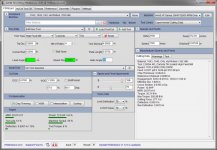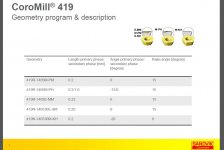recently we got a sandvik 419, 2 inch high feed mill. getting ready to try this thing out. i have 2 parts made out of 1045, that right now weigh 250 to 300#. will end up like 40#.
ran their calculator online, it gives me 975 sfm (2190 rpm), .031 fpt (275 ipm), 1.1 step over and .075 doc.
holy crap is that right???

i know these things move, all i've seen are videos, and the little bit i've been able to dig up here.
and then another question, i have an area on this part that is 4.13 deep with a 90 degree shoulder. so with this type tool and say face mill arbor with 3 inch gage length be doable???
Just curious, but where in Central Kentucky are you?
The only thing I would recommend, is cut the depth of cut in half, or at least 2/3 for your first run. .07" on a high-feed mill is pretty deep. You want to find out how your machine likes this type of cutting before you try to go for maximum performance.
Using high-feed mills in long-length holders is no problem. Like others have mentioned, the cutting pressure is turned almost completely axial,
(in the Z direction,) so even long cutters are still plenty rigid during the cut.
The only thing you need to be aware of is when cutting interior pockets with 90* walls, and here's why... Most of these cutters have a 10* lead-angle, so when they cut, the leave a 10* corner behind. When you approach side-wall on your next Z-pass, you will have to cut the D.O.C. of your current pass, + the 10* corner left behind from the 1st pass. Assuming there is no draft in your part, and you have repeated Z-passes cutting against the same shoulder, the cutter will be taking the full D.O.C. as it is cutting away the 10* corner from the previous depth pass.
What you will notice is, that if the last pass against a shoulder is at the same radial step-over, you will now be cutting the step-over width, + the 10* corner, and will notice a big spike in spindle load and cutting pressure. I've attached a drawing to help show the point - Hopefully I'm making sense...
To avoid this, I'd try to manipulate my toolpaths, so that I stay away from finishing the corner at a full width. Instead, I'd like to leave only a narrow band near the walls, and then mill away this narrow band by itself. It may also become necessary to reduce the feedrate on this last perimeter pass as well, because as seen in the illustration, when cutting away the previous pass' leftover material, the corner radius will be cutting material away - and there's no chip-thinning effect going on at the corner-radius...
Edit to add:After thinking about this some more, I suppose this becomes less of a problem, the closer you get to the max D.O.C, as the normal-cutting and corner-cutting loads become closer. Maybe that's why Sandvik recommends the .075" D.O.C.

If that's the case - that it's best to run high-feed mills at their maximum D.O.C. - then I suppose it's critical to match the cutter's diameter to your machine's limitations... Hmm, more food for thought...

 i know these things move, all i've seen are videos, and the little bit i've been able to dig up here.
i know these things move, all i've seen are videos, and the little bit i've been able to dig up here. i know these things move, all i've seen are videos, and the little bit i've been able to dig up here.
i know these things move, all i've seen are videos, and the little bit i've been able to dig up here.


 If that's the case - that it's best to run high-feed mills at their maximum D.O.C. - then I suppose it's critical to match the cutter's diameter to your machine's limitations... Hmm, more food for thought...
If that's the case - that it's best to run high-feed mills at their maximum D.O.C. - then I suppose it's critical to match the cutter's diameter to your machine's limitations... Hmm, more food for thought... 



